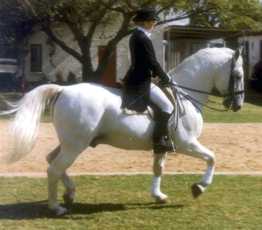
Ever wondered what those comments on your dressage test mean?
Well here are some of the terms used by dressage judges, and what is meant by them!
Lacking impulsion
This remark will be made if the horse has insufficient
energy to keep him going forward at a regular speed, or if he is virtually dropping
into a lower pace.
Correction
Impulsion is not speed! It is the energy in the hindquarters, which can be built up with exercises,
so that he is able to propel himself forward without difficulty and do as his
rider asks. If the hind quarters are not engaged, that is , not underneath the
horse s body, the impulsion will be misplaced and if the hind legs are working
behind the quarters, the horse will be thrusting forward all the time and will
not be balanced.If the hindlegs come well under the horse he will push
himself up a little as well as forward, which will give spring to his stride thus
enabling him to support himself, his weight and his rider's weight.
Above The bit
This means the horse is evading the bit. It is recognized
by the horse carrying his head too high so that he cannot be easily controlled.
While his head is in the air his nose is well in front of the vertical thus the
action of the bit is ineffective.The horse will be hollow in the back and unbalanced
making it difficult to carry himself and his rider. This evasion is a serious
fault as it prevents the development of the correct muscles, therefore hindering
the horse's progress, it must be corrected before training proceeds.
Correction
A horse that is above the bit has not been taught, or not understood,
that when a rider takes a contact on his mouth he must yield and not resist.
The horse should be kept at a slow speed at first, preferably in walk.Maintaining
a slow walk with a firm contact, the rider must make sure that the horse is going
forwards. He must not keep a dead pull on the reins but must move the bit gently
in the horse's mouth by squeezing one rein and then the other. As long as the
reins are not loosened, after a period of time the horse will lower his head into
a better position, the rider should then control this improved head position with
a light contact. Most riders give up before this is achieved and the correction
is never established. If the rider perseveres and the horse lowers his head, he
should be rewarded with a pat on the neck. All this may take several days
as it should only be carried out for short periods each day.But with patience
he will learn to keep his head in the correct position.
Abrupt transition
A transition is a change from one pace to another. Apart from the four natural gaits
it also applies to an alteration of stride within a pace such as collection to extension.
An abrupt transition usually occurs if the rider has given his aids too suddenly and without sufficient preparation.
As a result he may lose, balance, rhythm and head-carriage e.t.c. Whilst
training the rider should aim to make all transitions as smooth as possible. The
rider must allow for a time lapse, for the messages to get from his brain to his
muscles and in turn to the horse's. The rider must prepare the horse and let
him know something different is about to happen.These warning aids are called
half halts.
This is the BHS definition of a half halt.
The half halt is a hardly visible almost simultaneous,
co-ordinated action of the seat, the legs and the hand of the rider with the object
of increasing the attention and balance of the horse before the execution of several
movements or transitions to lesser and higher paces. In shifting slightly more
weight onto the horse's quarters, the engagement of the hind legs and the balance
on the haunches are facilitated, for the benefit of the lightness of the forehand
and the horse's balance as a whole.The half halts correctly used are of vital
value in the training of the horse. In the early stages with the young horse the
experienced rider uses the half halt in a very minor degree. It may be necessary
to use them frequently to help the horse stay in balance and to improve the quality
of the steps by making the rhythm constant.Later, the hind legs may be brought
more under the horse by slightly stronger aids, but only when the horse is physically
ready to carry more weight on his hindquarters.If the horse is correctly prepared
for the transitions by the use of half halts to maintain balance, and if there
is no resistance to the hand, the rider should be able to take the horse smoothly
from one pace to another. Straightness must also be a vital factor.
MORE TERMS COMING SOON! KEEP CHECKING BACK
|







